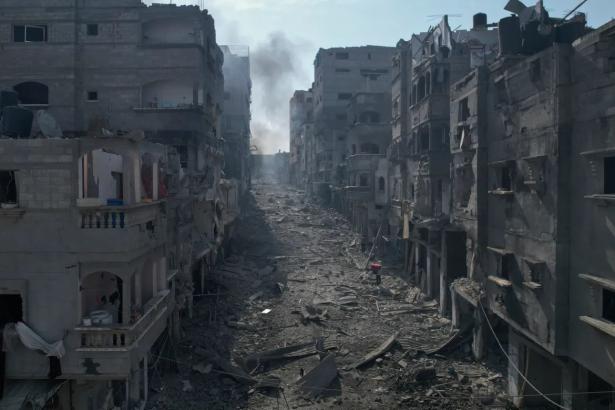The Israel Defence Forces (IDF) are poised to start ground operations in northern Gaza and the intended outcome is clear – the termination of Hamas. But previous experience suggests that despite being the far superior military force, they will fail.
Israel is planning a “three-phase” operation. The first phase has started with an intense air bombardment and will continue with ground operations aimed at “neutralising terrorists and destroying Hamas infrastructure”, in the words of Israel’s defence minister, Yoav Gallant.
The second phase will involve destroying any remaining resistance and this will be followed by the final phase, creating a substantial buffer zone around Gaza. With Hamas defeated, the strip will be cut loose from Israel and will presumably become the responsibility of the international community, perhaps including provision of power, water, food and other needs.
This war is the fifth between Hamas and Israel since 2008. The four previous wars and related violence cost 5,365 Palestinian lives and 308 Israeli lives. In the current war, at least 1,400 Israelis, including 279 soldiers, were killed and a further 3,400 wounded on 7 October. So far in the wide-ranging IDF response, nearly 6,000 Palestinians have been killed, including more than 2,000 children, and more than 16,000 peoplehave been wounded. A further 29 UN relief workers have been killed.
In only one of the previous wars, July 2014, did the IDF mount a major ground incursion – and its elite Golani Brigade then took serious losses. This, and Hamas’s presumed preparedness makes it well-nigh certain that, this time, the IDF will use very heavy airpower in advance of any ground assaults. Counter-city destruction (devastating an urban area before involving ground troops) is a frequent feature of modern warfare, whether it is Russia in Chechnya and Ukraine or the US-led coalition in Iraq, especially the destruction of the old city of Mosul just six years ago.
In Gaza, many more districts will be destroyed, and infiltration tunnels will be hit repeatedly, many with the US-made GBU-28 “bunker busting” bomb. Israel already has about 100 of these and it may now have the more advanced GBU-72.
Given the utter determination of Benjamin Netanyahu’s government to destroy Hamas, many thousands more Palestinians will be killed and tens of thousands wounded. If the war eventually ends, the Palestinians of Gaza are likely to be contained in a far smaller area and subject to intense surveillance.
This takes us to the strategic dangers from Israel’s point of view. Instead of extinguishing Hamas, the war will result in tens of thousands more very angry young Palestinians set to join the organisation or a similar successor.
If the assumption is that this will be mitigated by heavy surveillance of 2 million Palestinians crammed into a small part of Gaza, then this ignores what is happening in the West Bank. There, more than 3 million Palestinians live under an occupation that has only worsened under Netanyahu’s hardline governments.
Moreover, the West Bank is very different from Gaza in two crucial respects. One is the rapid expansion of Israeli settlements which have a potent combination of ultranationalism and religious fundamentalism among settlers. This is strongly supported by religious parties in the Netanyahu government, some with a markedly “Kahanist” view of the Palestinians.
The second is that the settlements are so widespread across that whole territory, and many settlers are so determined to exercise control, that tensions with the majority Palestinian population are very high. The recent land grab at Ein Rashash is just one example of repeated encroachment on Palestinian land and has been paralleled by repeated acts of violence across the occupied territories. From the start of the year through to mid-September, 189 Palestinians have been killed and more than 8,000 injured.
The atrocities of 7 October will add to the determination of settlers to solidify their control over more territory, but the IDF will be reluctant to get closely involved in what might be urban warfare. There has just been a rare air attack on a suspected Hamas/Palestinian Islamic Jihad (PIJ) site in Jenin, but the IDF contribution in the West Bank has been much more of the order of intensive ground patrols.
These, though, have been resisted and in one incident earlier in the year, one of the IDF’s most modern armoured personnel carriers, designed specifically for use on the West Bank, was attacked and disabled in an attack near Jenin. The IDF response was to use massive force in a rare direct military incursion into the nearby refugee camp in Jenin. This was expected to curtail paramilitary activity, but the weekend’s air attack indicates it is failing.
Essentially, an intense destruction of Gaza could end up displacing the locus of conflict to the West Bank rather than actually ending it. Across much of the global south and especially the Middle East, an anti-Israel mood is growing that is radically different from support offered on and immediately after 7 October. Hamas already has support in the West Bank, and incompetence and corruption in the Palestinian Authority is rendering that body irrelevant. While the current international focus is inevitably on Gaza, the significance of the West Bank is being missed as is its potential to be the site of a neo-Hamas movement.
The Netanyahu government’s overall approach is making a very difficult problem even worse. A humanitarian-oriented ceasefire is still possible but will not happen unless the US, Britain and the EU specifically demand it. If they don’t, they will bear part of the responsibility for what happens next.
-
Paul Rogers is emeritus professor of peace studies at Bradford University and an honorary fellow at the Joint Service Command and Staff College


Spread the word